Purchasing a telescope eyepiece could improve how your telescope functions. But what does a telescope eyepiece do?
An eyepiece is important because it collects the light and it also controls your telescope’s field of view and magnification!
If the telescope you purchased doesn’t have a high-quality eyepiece, it doesn’t matter because you can replace it. Here are the best telescope eyepieces for 2024: get more out of your telescope.
Contents
Best Overall: Celestron Zoom Telescope Eyepiece
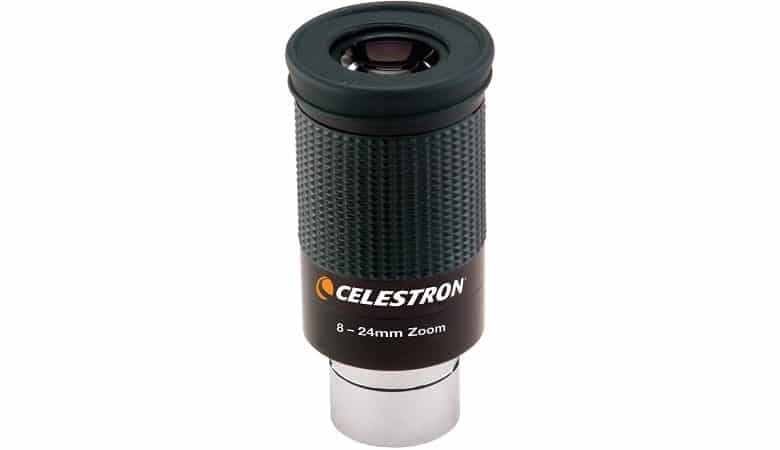
Sometimes you need to zoom into what you’re looking at to capture more details. This Celestron zoom eyepiece will help you do that, but here’s what you need to know about it.
Featured specs
- Long eye relief
- Up to 24mm focal length
- Rubber eye cap
Benefits
- This eyepiece makes it really easy to zoom into planets because you don’t have to change your telescope’s lens. This means you can easily switch to a different zoom without a problem.
- It’s compatible with all telescopes that have 1.25-inch eyepieces, so if you upgrade your telescope in the future, you’ll probably be able to use it.
- You’re not limited to using this eyepiece for astronomy. You can use it to see terrestrial views, thanks to its field of view.
- You also adjust this eyepiece’s focal length up to 24mm. This means that you will have everything you need in order to see a range of celestial objects.
Drawbacks
- Its focal lengths aren’t parfocal. This means that you need to adjust the focus of your telescope whenever you increase or decrease the magnification, which can be a hassle.
- Some people have reported that the eye cap sometimes detaches when they try to retract it.
Extra Features
- Despite this eyepiece’s rubber cap issue, if you wear glasses, it will certainly make your stargazing more comfortable.
- This eyepiece has eye relief that’s between 15mm and 18mm. This is known as long eye relief, which is more comfortable than shorter types.
Buying Guide
This telescope is worth purchasing because it will enable you to have a much more comfortable and convenient stargazing experience, and that’s what makes it one of the best telescope eyepieces for the money.
Runner Up: Orion E-Series 7-21mm Zoom Telescope Eyepiece
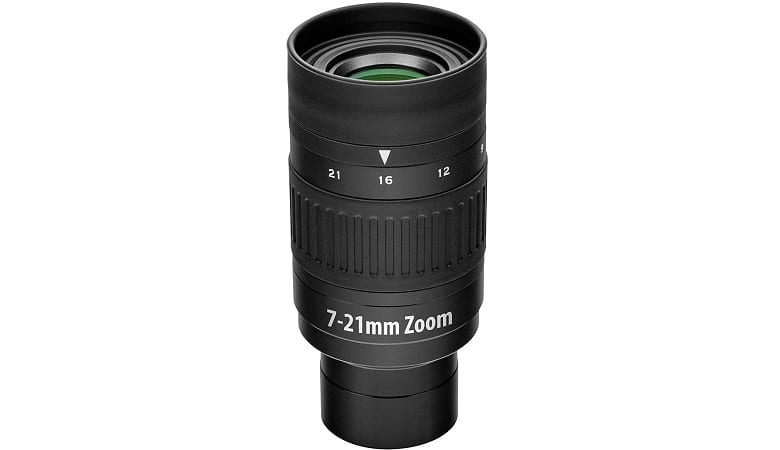
This eyepiece is perfect for when you’re looking at a celestial object and want to quickly zoom into it without having to change your eyepiece – just turn the dial and you’ll be able to see things much clearer. Let’s check it out in greater detail!
Featured specs
- Six lens elements
- Wide-angle view
- Anti-reflective coating
Benefits
- This Orion eyepiece enables you to simply twist it to change the focal length from 21mm to 7mm.
- It’s been constructed with six lens elements. These are fully multi-coated and have anti-reflective coating so that your view is always clear and never obstructed.
- This eyepiece comes with exceptional eye relief – you’re looking at 18mm to 16.3mm. This enables you to feel comfortable to use it if you wear spectacles.
Drawbacks
- Some people have reported that it’s a bit difficult to use at times because of how closely you have to put your eye to the glass in order to see the views.
Extra Features
- People who have purchased this eyepiece have stated that it has an excellent wide-angle view.
Buying Advice
This Orion eyepiece is really easy for anyone to use. It allows you to increase your field of view to better capture the beauty of the night sky.
Alternative: SVBONY Plossl Telescope Eyepiece
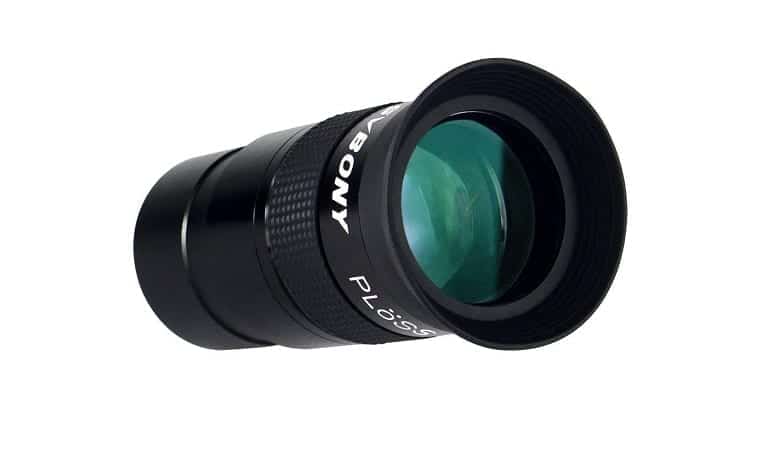
This Plossl eyepiece is of excellent quality, so if you’re looking for the best, look no further. It has lots going for it, so let’s check out its features in more detail!
Featured specs
- Fully coated
- Black interior
- Adjustable length
Benefits
- This eyepiece provides a 40-degree field of view, which is ideal for various observations of the night sky. You’ll even be able to see medium-sized star clusters!
- This is a high-quality Plossl eyepiece that’s fully coated to prevent the production of chromatic aberrations and enhance the contrast of your views.
- The eyepiece contains a black interior design to prevent unwanted light from sneaking in.
Drawbacks
- Some people have reported that the eyepiece feels more like it’s 25mm than 40mm.
Extra Features
- This telescope eyepiece comes with a rubber eye guard that has a bayonet mount and is soft, therefore making it comfortable for eyeglass wearers. Simply fold it down so it’s out of the way.
- The eyepiece’s length can be adjusted if you like. Simply disassemble it to make it shorter.
- It contains a 1.25-inch barrel that can fit with a variety of telescopes, thus making it very versatile.
Buying Advice
If you’re looking for a really budget-friendly eyepiece, this is the one to consider. While it doesn’t give you as much versatility as other eyepieces, such as when it comes to its focal length, it’s a quality option that’s worth it if you need an eyepiece that offers great star-viewing options.
Best Telescope Eyepiece Kit: Celestron Eyepiece and Filter Accessory Kit
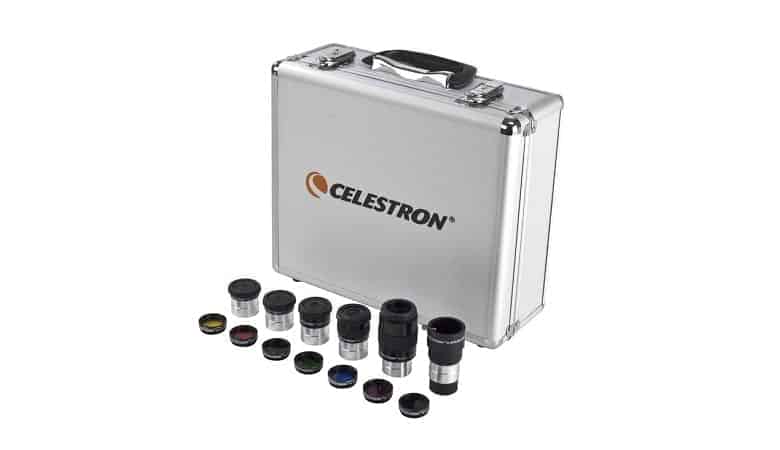
Forget about purchasing single eyepieces – maybe you’re looking for a kit to take your astronomy hobby up a notch. If that’s the case, you’re going to love this eyepiece kit from Celestron.
Featured specs
- 2x Barlow lens
- Plossl eyepieces
- Six color filters
Benefits
- This kit contains not one but five Plossl eyepieces that range in focal length from 6mm to 32mm. Enjoy clearer, sharper views of celestial objects!
- All the eyepieces that you’ll find in this kit contain a 52-degree FOV.
- The kit includes a Barlow lens that doubles the magnification of the eyepieces, making it easier than ever to zoom in on a constellation or planet and see its details better.
- Six colored filters are included, which is a nice touch and makes this the best telescope eyepiece for viewing planets.
Drawbacks
- Some people have stated that the case in which this kit comes is sturdy but doesn’t provide much room for expansion, such as if you want to add more filters and eyepieces to your collection.
- There’s no solar filter included in the pack, which would have made this kit feel more complete.
Extra Features
- As a bonus, you’ll enjoy using the moon filter that’s included. This will help you to be able to look at the moon without your view being obstructed by its glare.
Buying Advice
If you’re serious about astronomy and will have lots of use for various eyepieces and filters, this Celestron eyepiece kit is a solid choice for you.
Runner Up: Meade 607010 Series Telescope Eyepiece and Filter Set
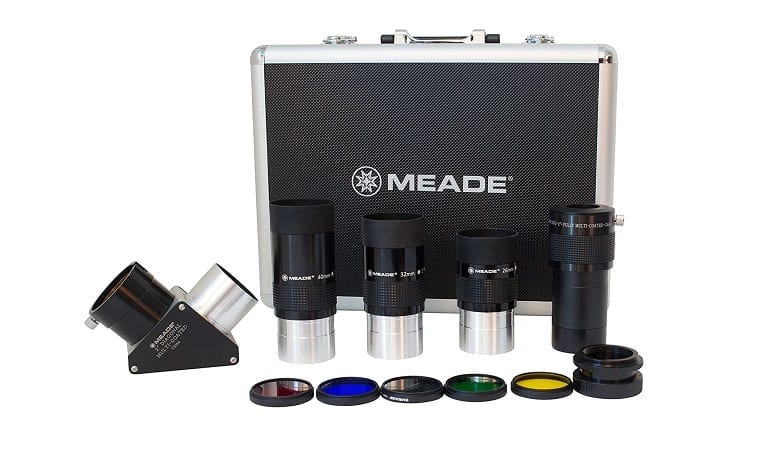
This is another kit that comes with eyepieces and filters. Let’s check out what it has to offer.
Featured Specs
- Fully multi-coated optics
- Five color filters
- Diagonal mirror
Benefits
- The eyepieces in this kit all come with 52-degree FOV and have been made out of premium optical glass.
- You’ll be able to enjoy views of celestial objects that have enhanced contrast and excellent light, thanks to the fully multi-coated optics.
- This kit comes with a Barlow eyepiece included, so you can increase the magnification of your views.
- You get five color filters in this set that will help you to see more planetary and constellation details. For example, the red filter will be effective if you want to view more details on Mars, while the yellow one will help you to bring out details of Jupiter’s cloud belts.
Extra Features
- The eyepieces have a soft rubber eye guard included for extra comfort, especially if you’re using them for many hours at a time.
- With your purchase, you’ll receive an aluminum carry case, which will allow you to easily and conveniently store all your items.
- People have stated that you also get a 90-degree diagonal mirror included with the kit. A diagonal mirror is useful because it flips the telescope’s view at a 45- or 90-degree angle so that it’s correctly oriented vertically.
Buying Advice
This Meade astronomy kit contains some of the best telescope eyepieces. It’s much more expensive than the previous kit we featured, but it offers many excellent features. This kit is a fantastic introduction to astronomy, and you’ll likely want to purchase items to add to it soon.
Telescope Eyepiece FAQ
Now that you know a bit more about the best telescope eyepieces that are on the market, let’s explore eyepieces in more detail.
Types of telescope eyepieces
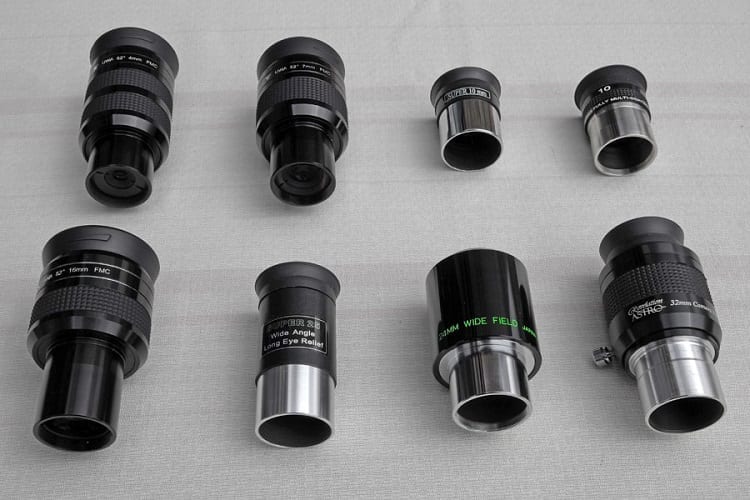
You can’t have a functional telescope without the use of an eyepiece that collects light so that you can see what’s in the sky above you. There are many different types of eyepieces available, with different sizes and magnifications.
The two most common eyepiece sizes are 1.25-inch telescope eyepieces and 2-inch eyepieces.
Almost all eyepieces are 1.25-inch, with various lenses and filters being made to thread onto these, therefore proving how versatile they are. As for two-inch eyepieces, they are low-power and wide-field items. They can also be paired with filters and Barlow lenses, though.
The most important eyepiece types to know about are:
1. Huygens and Ramsden Eyepieces
These are usually found in cheap telescopes because they don’t cost a lot of money to produce. Their biggest drawback, however, is that they produce aberrations.
2. Kellner Eyepiece
This 3-lens type of eyepiece has an achromatic lens included to help to prevent color errors.
3. Orthoscopic Eyepiece
This eyepiece has four lenses. It offers higher levels of magnification, making it ideal for viewing the planets and moon.
4. Plossl Eyepiece
This is a well-known eyepiece that has four or five lenses in its design. What makes it so popular is how it enhances color and offers excellent eye relief.
5. Wide-Field Eyepiece
This eyepiece offers a field of view that’s greater than 50 degrees. A type of wide-field eyepiece known as the Naler is considered the gold standard because of how it can deliver 80-degree views and higher, but it is very expensive.
So, which ones should you purchase?
It can feel overwhelming to know what types of eyepieces you will need, but basically, you don’t need that many in order to enhance your astronomy views. A solid collection of the following (via Sky At Night) is more than sufficient for your needs:
- A high magnification eyepiece to zoom into your views. Remember that the smaller the focal length number, such as 10mm, the stronger the magnification!
- A wide/ultra-wide angle eyepiece.
- A medium power eyepiece, such as one that’s got approximately 18mm focal length to improve your views.
- A Plossl eyepiece. This is always a valuable addition to your kit because it offers you wide fields of view.
As an extra note, a Barlow lens is also very useful. It intercepts light inside the telescope so that it can double, or even triple, the magnification of what you get from your eyepiece.
Understanding the Telescope Eyepiece
https://www.youtube.com/watch?v=DODk3cJam68u0026ab_channel=EyesontheSky
It’s useful to know how telescope eyepieces work and why they’re important. As we mentioned earlier, eyepieces collect light so that you can better see planets and stars when you look at the sky with your telescope.
Some telescopes that you can purchase on the market come with low-quality eyepieces, but when you change them, you’ll be quite surprised at the difference in what you can see.
While there’s always an emphasis placed on choosing the best telescope for your astronomy needs, the eyepiece is the component that really makes a difference in how well the telescope can work.
It’s important to note the different functions of eyepieces with different magnifications, so let’s examine high-, medium-, and low-power eyepieces in more detail.
Low-power eyepiece
This enables you to view larger celestial objects, such as planets, and frame many of them in a single view. You could find one that’s about 40mm focal length to help you achieve these goals.
Medium-power eyepiece
This eyepiece lets you see many more details, such as the planets and star clusters. When you increase the magnification of your eyepiece, this has the effect of making the sky darker to improve the contrast of your views. An example of a medium-power eyepiece is a 32mm focal length.
High-power eyepiece
This one is obviously focused on letting you see even more details in space objects, so you’ll want to reach for it when you view the planets through your telescope. An eyepiece with a focal length of 15mm will be considered a high-power one.
Cleaning your telescope eyepieces
https://www.youtube.com/watch?v=yqLaPPexjzou0026ab_channel=RotherValleyOptics
When cleaning your telescope eyepieces, you must be very careful not to damage their coating.
A quick and easy way to eliminate dust from your eyepiece before using it is to brush it with a photographic-grade camel hair brush which you can purchase from camera shops. The camel hair is soft, so it won’t scratch your eyepiece.
If there are marks or stains on your eyepiece you wish to remove, an excellent product is the Lens Pen. It makes use of a carbon formula instead of liquid in a pen-like structure, enabling you to easily wipe away stains from your eyepiece without leaving residue behind.
Another effective way to clean your telescope’s eyepiece is to use a can of compressed air. This will blow away any dust and debris from the eyepiece’s surface.
This is important to do before you clean the eyepiece with a liquid; otherwise, those particles can scratch the eyepiece coating.
After using the compressed air, you should dip a cotton ball in a solution of isopropyl alcohol. Carefully swipe it across the eyepiece lens, being careful not to rub it back and forth as that can cause scratches on it.
Once you’re done, you can use a second dry cotton ball on the lens. If the cotton ball has left behind a bit of fluff, you can remove it with the camel brush or compressed air.
Prevent dirt from accumulating on your eyepieces in the future so that you don’t have to clean them by storing them in a sealed container that won’t collect dust. You should also make sure you avoid handling the eyepieces as much as possible.
Wear gloves when touching them to prevent fingerprints on them. The oils in the skin can lead to residue and cause stains to form on the eyepiece lens, so you want to avoid touching them as much as possible!
Should you buy used telescope eyepieces?
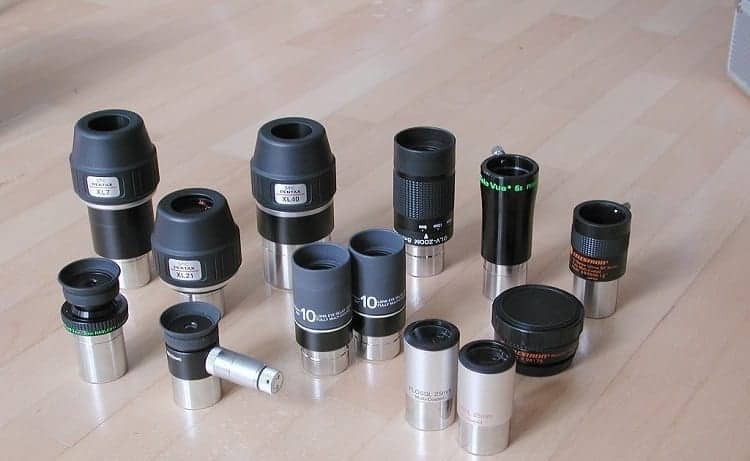
Eyepieces can be expensive, so you might want to consider purchasing second-hand ones to save some money. There’s nothing wrong with this, provided that you ensure that the eyepieces are in good condition.
It’s always a good idea to check the eyepieces before you purchase them. You want them to have covers; otherwise, that could point to how they weren’t properly looked after by their previous owner.
As a result, they could be dirty (which means you’ll have to clean them), or the accumulation of dust and dirt could have caused them to become scratched.
There are some excellent places where you can purchase second-hand eyepieces (as well as other astronomy gear), such as High Point Scientific.
Here, all the gear and accessories are put to the test to ensure they perform optimally – and there’s a return policy in place! Another website to check out is Woodland Hills Telescope. They have a variety of brand-name telescope eyepieces for sale.
What about private sellers?
Even though you can find some of the best budget telescope eyepieces that aren’t brand new from individual sellers, it’s worth bearing in mind that a private sale could cause you to miss out on benefits such as warranties and the chance to return your eyepiece should something go wrong, which is why it’s important to use a reputable company.
Choosing a reputable retailer usually also means that you can take advantage of their trade-in programs. When items are taken in by the company to be resold, they will be tested to ensure that they perform well.
You can’t always be guaranteed that the private seller who wants you to buy their eyepieces took good care of them or even that they work, so if you want to purchase second-hand astronomy gear, stick with reputable companies.
Conclusion
Now that you’ve read this article and our best telescope eyepieces reviews, you have a much better idea of why eyepieces are so important and why you should add more of them to your astronomy collection!

